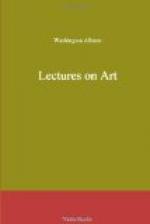Will any man say, that he is wholly without some natural or acquired bias? This is the source of the counteracting influence which we speak of in ourselves; but which, like many other of the secret springs, both of thought and feeling, few men think of. It is nevertheless one which, on this particular subject, is scarcely ever inactive; and according to the bias will be our impressions, whether we be intellectual or sensual, coldly speculative or ardently imaginative. We do not mean that it is always called forth by every thing we approach; we speak only of its usual activity between man and man; for there seems to be a mysterious something in our nature, that, in spite of our wishes, will rarely allow of an absolute indifference towards any of the species; some effect, however slight, even as that of the air which we unconsciously inhale and again respire, must follow, whether directly from the object or reacting from ourselves. Nay, so strong is the law, whether in attraction or repulsion, that we cannot resist it even in relation to those human shadows projected on air by the mere imagination; for we feel it in art only less than in nature, provided, however, that the imagined being possess but the indication of a human soul: yet not so is it, if presenting only the outward form, since a mere form can in itself have no affinity with either the heart or intellect. And here we would ask, Does not this striking exception in the present argument cast back, as it were, a confirmatory reflection?
We have often thought, that the power of the mere form could not be more strongly exemplified than at a common paint-shop. Among the annual importations from the various marts of Europe, how many beautiful faces, without an atom of meaning, attract the passengers,—stopping high and low, people of all descriptions, and actually giving pleasure, if not to every one, at least to the majority; and very justly, for they have beauty, and nothing else. But let another artist, some man of genius, copy the same faces, and add character,—breathe into them souls: from that moment the passers-by would see as if with other eyes; the affections and the imagination then become the spectators; and, according to the quickness or dulness, the vulgarity or refinement, of these, would be the impression. Thus a coarse mind may feel the beauty in the hard, soulless forms of Van der Werf, yet turn away with apathy from the sanctified loveliness of a Madonna by Raffaelle.
But to return to the individual bias, which is continually inclining to, or repelling, What is more common, especially with women, than a high admiration of a plain person, if connected with wit, or a pleasing address? Can we have a stronger case in point than that of the celebrated Wilkes, one of the ugliest, yet one of the most admired men of his time? Even his own sex, blinded no doubt by their sympathetic bias, could see no fault in him, either in mind or person; for, when it was objected to the latter, that “he squinted confoundedly,” the reply was, “No, Sir, not more than a gentleman ought to squint.”




